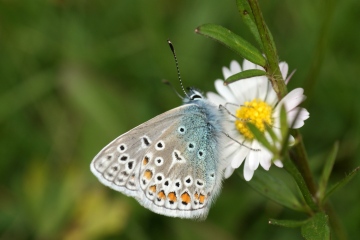Species Account for Polyommatus icarus
Polyommatus icarus (Rottemburg, 1775)
Common Blue
Lepidoptera: butterflies: Lycaenidae

Reproduction for study and non-profit use permitted, all other rights reserved.
Taxonomic group: butterflies (Lepidoptera: butterflies) - County data
View time series maps for Polyommatus icarus
member log-on for taxon report
Images
upload a new image
Common Blue on UK Butterflies website
Species text
The most widespread of the blues in Britain, the Common Blue is found on unimproved grassland, wasteland and on sea walls. Its larvae feed mainly of Bird's Foot Trefoil (Lotus corniculatus) but other plants are used. There are usually 2 broods each year, the first emerging in May, peaking in early June and the second emerging in July, peaking in early August. When conditions are favourable, the second brood can be extremely abundant, as was the case in 2010. In warm years, a small partial third brood sometimes appears in early October, often at Canvey Island and other Thames coastal sites. The Common Blue overwinters in the larval state. The Common Blue is usually separated from the Holly Blue by its low-level sorties over grassland but it can occassionally rise up high over vegetation making in-flight identification difficult. References
Habitats
Recorded management for locations with Polyommatus icarus
Recorded substrate and hydrology for locations with Polyommatus icarus
Why not join the Club, register and add a new species page
Interpretation of distribution maps

























